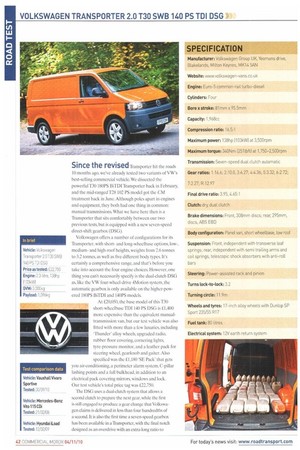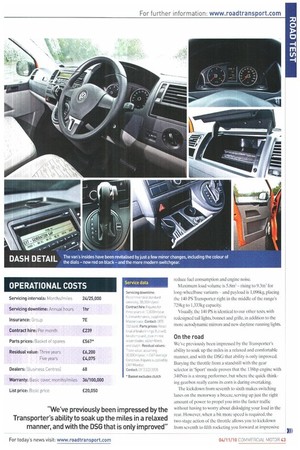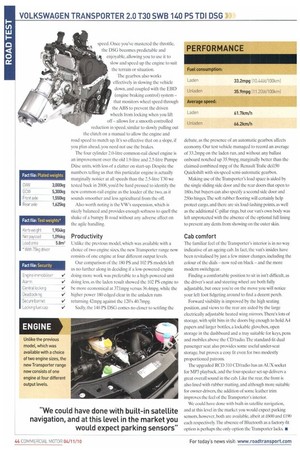Since the revised Transporter hit the roads 10 months ago,
Page 42

Page 43

Page 44

If you've noticed an error in this article please click here to report it so we can fix it.
we've already tested two variants of VW's best-selling commercial vehicle. We dissected the powerful T30 180PS BiTDI Transporter back in February, and the mid-ranged 128 102 PS model got the CM treatment back in June. Although poles apart in engines and equipment, they both had one thing in common: manual transmissions. What we have here then is a Transporter that sits comfortably between our two previous tests, but is equipped with a new seven-speed direct-shift gearbox (DSG).
Volkswagen offers a number of configurations for its Transporter, with shortand long-wheelbase options, low-, mediumand high-roof heights, weights from 2.6 tonnes to 3.2 tonnes, as well as five different body types. It's certainly a comprehensive range, and that's before you take into account the four engine choices. However, one thing you can't necessarily specify is the dual-clutch DSG as, like the VW four-wheel-drive 4Motion system, the automatic gearbox is only available on the higher-powered 180PS BiTDI and 140PS models.
At £20,050, the base model of this T30 short-wheelbase TDI 140 PS DSG is £1,400 more expensive than the equivalent manualtransmission van, but our test vehicle was also fitted with more than a few luxuries, including 'Thunder' alloy wheels, upgraded radio, rubber floor covering, cornering lights, tyre-pressure monitor, and a leather pack for steering wheel, gearknob and gaiter. Also specified was the £1,180 'SE Pack' that gets you air-conditioning, a perimeter alarm system, C-pillar lashing points and a full bulkhead, in addition to an electrical pack covering mirrors, windows and lock. Our test vehicle's total price tag was £22,750.
The DSG uses a dual-clutch system that allows a second clutch to prepare the next gear, while the first is still engaged to produce a gear change that Volkswagen claims is delivered in less than four hundredths of a second. It is also the first time a seven-speed gearbox has been available in a Transporter, with the final notch designed as an overdrive with an extra-long ratio to reduce fuel consumption and engine noise.
Maximum load volume is 5.8m3rising to 9.3m for long-wheelbase variants and payload is 1,096kg, placing the 140 PS Transporter right in the middle of the range's 729kg to 1,333kg capacity.
Visually, the 140 PS is identical to our other tests, with redesigned tail lights, bonnet and grille, in addition to the more aerodynamic mirrors and new daytime running lights, On the road We've previously been impressed by the Transporter's ability to soak up the miles in a relaxed and comfortable manner, and with the DSG that ability is only improved. Burying the throttle from a standstill with the gear selector in 'Sport' mode proves that the 138hp engine with 340Nrn is a strong performer, hut where the quick-thinking gearbox really earns its corn is during overtaking.
The kickdown from seventh to sixth makes switching lanes on the motorway a breeze, serving up just the right amount of power to propel you into the faster traffic without having to worry about dislodging your load in the rear. However, when a bit more speed is required, the two-stage action of the throttle allows you to kickdown from seventh to fifth rocketing you forward at impressive speed. Once you've mastered the throttle, the DSG becomes predictable and enjoyable, allowing you to use it to slow and speed up the engine to suit the terrain or situation.
The gearbox also works effectively in slowing the vehicle down, and coupled with the EBD (engine braking control) system — that monitors wheel speed through the ABS to prevent the driven wheels from locking when you lift off— allows for a smooth controlled reduction in speed, similar to slowly pulling out the clutch on a manual to allow the engine and road speed to match up. It's so effective that on a slope, if you plan ahead, you need not use the brakes.
The four cylinder 2.0-litre common-rail diesel engine is an improvement over the old 1.9-litre and 2.5-litre Pumpe Duse units, with less of a clatter on start-up. Despite the numbers telling us that this particular engine is actually marginally noisier at all speeds than the 2.5-litre T30 we tested back in 2008, you'd be hard pressed to identify the new common-rail engine as the louder of the two, as it sounds smoother and less agricultural from the off.
Also worth noting is the 'VW's suspension, which is nicely balanced and provides enough softness to quell the shake of a bumpy B-road without any adverse affect on the agile handling.
Productivity
Unlike the previous model, which was available with a choice of two engine sizes, the new Transporter range now consists of one engine at four different output levels Our comparison of the 180 PS and 102 PS models left us no further along in deciding if a low-powered engine doing more work was preferable to a high-powered unit doing less, as the laden result showed the 102 PS engine to be more economical at 371mpg versus 36.4mpg, while the higher power 180 edged clear in the unladen runs returning 42mpg against the 120's 40.7mpg.
Sadly, the 140 PS DSG comes no closer to settling the debate, as the presence of an automatic gearbox affects economy. Our test vehicle managed to record an average of 33.2mpg on the laden run, and without any ballast onboard notched up 35.9mpg, marginally better than the claimed combined mpg of the Renault Trak dci150 Quickshift with six-speed semi-automatic gearbox.
Making use of the Transporter's load space is aided by the single sliding side door and the rear doors that open to 180o, hut buyers can also specify a second side door and 250o hinges.The soft rubber flooring will certainly help protect cargo, and there are six load-lashing points, as well as the additional C-pillar rings, but our van's own body was left unprotected with the absence of the optional full lining to prevent any dents from showing on the outer skin.
Cab comfort
The familiar feel of the Transporter's interior is in no way indicative of an ageing cab. ln fact, the van's insides have been revitalised by just a few minor changes, including the colour of the dials — now red on black — and the more modern switchgear.
Finding a comfortable position to sit in isn't difficult, as the driver's seat and steering wheel are both fully adjustable, but once you're on the move you will notice your left foot fidgeting around to find a decent perch.
Forward visibility is improved by the high seating position, and views to the rear are aided by the large electrically adjustable heated wing mirrors There's lots of storage, with split bins in the doors big enough to hold A4 papers and larger bottles, a lockable glovebox, open storage in the dashboard and a tray suitable for keys, pens and mobiles above the CD/radio.The standard-fit dual passenger seat also provides some useful under-seat storage, but proves a cosy fit even for two modestly proportioned patrons.
The upgraded RCD 310 CD/radio has an AUX socket for MP3 playback, and the four-speaker set-up delivers a great overall sound in the cab. Like the rear, the front is also lined with rubber matting, and although more suitable for owner-drivers, the addition of some leather trim improves the feel of the Transporter's interior.
We could have done with built-in satellite navigation, and at this level in the market you would expect parking sensors, however, both are available, albeit at £600 and £190 each respectively.The absence of Bluetooth as a factory-fit option is perhaps the only option the Transporter lacks. •




































































































































